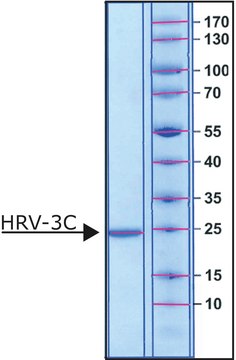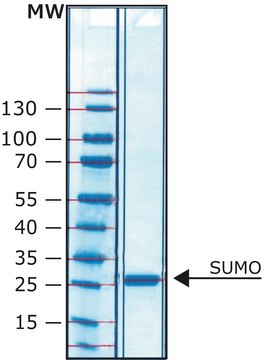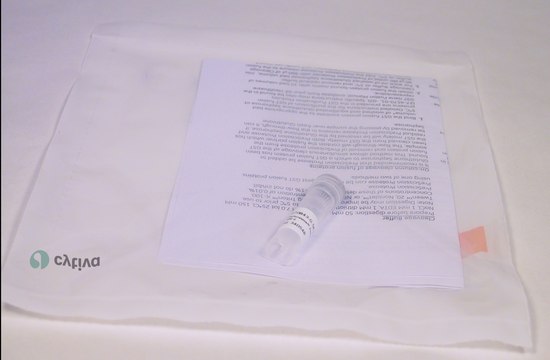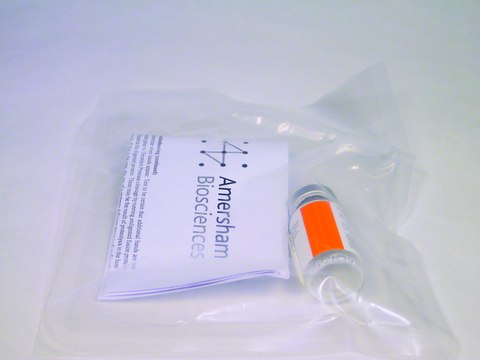H9916
HRV3C Protease
recombinant, expressed in E. coli, ≥99% (SDS-PAGE)
Synonym(s):
Human Rhinovirus 3C Protease
Sign Into View Organizational & Contract Pricing
All Photos(1)
About This Item
UNSPSC Code:
12352204
Recommended Products
recombinant
expressed in E. coli
description
For cleavage of fusion proteins containing LeuGluValLeuPheGln/GlyPro sequence
Assay
≥99% (SDS-PAGE)
form
liquid
specific activity
≥1 units/μg
mol wt
47 kDa
storage temp.
−20°C
General description
HRV3C Protease is a recombinant restriction-grade cysteine protease. It folds into two topologically alike six-stranded β barrels. However, β barrels are different in length and individual position as well as in loops connecting elements of secondary structure. The protease is distinguishable from others by the fact that it has a cysteine nucleophile but with a chymotrypsin-like serine protease folding.
Application
HRV3C Protease has a therapeutic implication because of its unique protein structure. It may be used for the biochemical and structural characterization conducted on HRV 3C protease along with the development of 3C protease inhibitors.
Human rhinovirus 3C protease (HRV3C Protease) is a cysteine protease that recognizes the cleavage site of Leu-Glu-Val-Leu-Phe-Gln*Gly-Pro. Supplied as a 47 kDa protein with both GST and Histidine tags for easy removal by His-Select or Glutathione agarose along with the cleaved tag.
Biochem/physiol Actions
Human rhinovirus 3C protease (HRV3C Protease) is a cysteine protease that recognizes the cleavage site of Leu-Glu-Val-Leu-Phe-Gln*Gly-Pro. It is supplied as a 47 kDa protein with both GST and Histidine tags for easy removal by His-Select or Glutathione agarose along with the cleaved tag. HRV3C Protease is capable of cleaving small peptides with the sequence of polyprotein processing sites. It cleaves after the glutamine residue. HRV cleavage site generally contains Gln/Gly scissile bond.
Unit Definition
1 unit of HRV3C protease cleaves >95% of 100 μg of control target protein at 4 deg C for 16 hours.
Physical form
Supplied as a solution in 25 mM Tris-HCl, pH 8.0, 50 mM NaCl, 1 mM TCEP and 50% glycerol
Preparation Note
It is recommended to use HRV3C Protease at a protease-to-target protein ratio of 1:100 (w/w) or 1 unit of HRV3C Protease to 100 μg of target protein in a buffer suitable for the target protein at 4 °C overnight, with the target protein concentration at 1-2 mg/ml. In most cases, target proteins are completely cleaved with a protease to target protein ratio of 1:50 to 1:400, or 1 unit HRV3C Protease to 50-400 μg of target protein. The efficiency of cleavage may vary due to the sequences around the cleavage site, conformation and the solubility of the target protein. Due to its high specificity, more HRV3C Protease (at 1:10 ratio) or longer cleavage time at higher temperature (37 °C) can be used to achieve high cleavage efficiency without non-specific cleavage of target proteins.
Storage Class Code
10 - Combustible liquids
WGK
WGK 2
Flash Point(F)
Not applicable
Flash Point(C)
Not applicable
Regulatory Information
常规特殊物品
Choose from one of the most recent versions:
Already Own This Product?
Find documentation for the products that you have recently purchased in the Document Library.
Q May Wanga et al.
Current protein & peptide science, 8(1), 19-27 (2007-02-20)
As the major cause of the common cold in children and adults, human rhinoviruses (HRVs) are a group of small single-stranded positive-sense RNA viruses. HRVs translate their genetic information into a polyprotein precursor that is mainly processed by a virally
M G Cordingley et al.
The Journal of biological chemistry, 265(16), 9062-9065 (1990-06-05)
A series of synthetic peptides representing authentic proteolytic cleavage sites of human rhinovirus type 14 were assayed as substrates for purified 3C protease. Competition cleavage assays were employed to determine the relative specificity constants (Kcat/Km) for substrates with sequences related
D A Matthews et al.
Cell, 77(5), 761-771 (1994-06-03)
The structure of human rhinovirus-14 3C protease (3Cpro) has been determined at 2.3 A resolution and refined to an R factor of 0.22. This cysteine protease folds into two topologically equivalent six-stranded beta barrels and in this sense is similar
Adam Dyer et al.
Bioscience reports, 35(4), doi:10-doi:10 (2015-07-17)
The deep evolutionary history of the Spirochetes places their branch point early in the evolution of the diderms, before the divergence of the present day Proteobacteria. As a spirochete, the morphology of the Borrelia cell envelope shares characteristics of both
Yazi Li et al.
Autophagy, 13(7), 1145-1160 (2017-06-21)
The majority of diabetic patients develop neuropathy and there is an increasing prevalence of neurodegeneration in the central nervous system (CNS). However, the mechanism behind this is poorly understood. Here we first observed that macroautophagy/autophagy was suppressed in the hippocampus
Our team of scientists has experience in all areas of research including Life Science, Material Science, Chemical Synthesis, Chromatography, Analytical and many others.
Contact Technical Service






